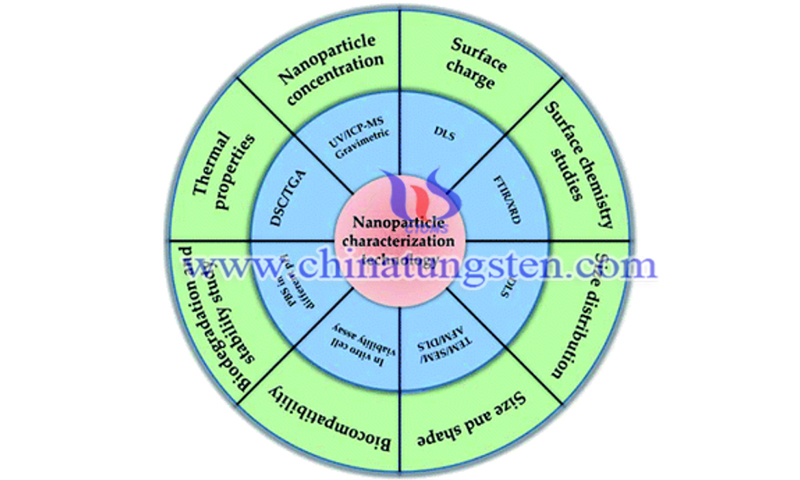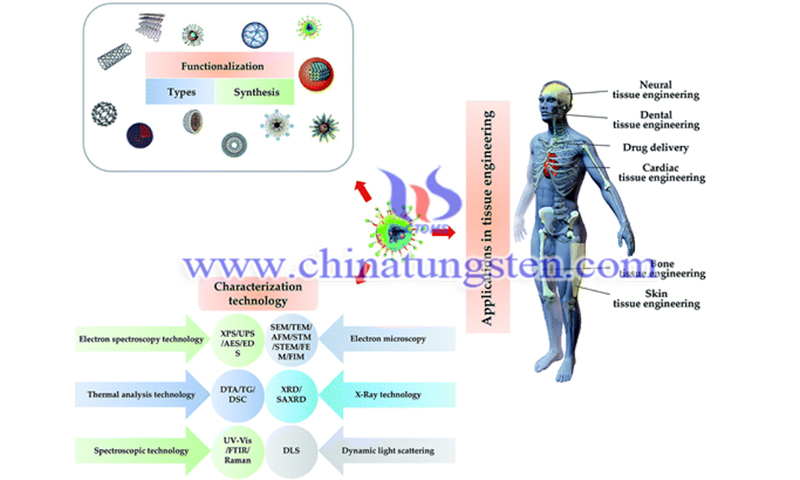WS2NM-Based Nanocarriers and Application in Tissue Engineering
- Details
- Category: Tungsten Information
- Published on Tuesday, 16 August 2022 22:45
Recently, WS2NM-based nanocarriers have been developed in drug delivery systems, which also promote their application in tissue engineering. Due to the electrical properties of WS2, researchers have designed tungsten disulfide nanomaterials (WS2NM)-based electro-responsive drug delivery systems. Conventional drug delivery systems, such as oral and injectable, require higher concentrations of drugs to see therapeutic effects, and administering too much of the drug can lead to side effects in some patients.
Comparing WS2NM-based nanocarriers with conventional drug delivery systems, the total amount of drug released in vitro without IR irradiation was 18% and 98% at 37 and 50 degrees Celsius, respectively. However, in the presence of near-infrared laser irradiation, the WS2 nanocarrier drug release reached 100% within 15 minutes.
Nanomaterials can be used for tissue engineering to fabricate high-performance scaffolds, implants, and medical devices. WS2 nanomaterials are new candidates for the development of tissue engineering and nanomedicine. Due to the electrical and mechanical properties of tungsten disulfide (WS2), they can be used for scaffold reinforcement, tissue engineering, and drug delivery design.

(Picture source: Xinmin Zheng et al./The Royal Society of Chemistry)
In orthodontic treatment, movement of the teeth along the archwire creates frictional forces between the archwire and brackets in the opposite direction of the orthodontic forces. Whereas the focus used to be on engineering brackets, the focus now is on reducing frictional forces, which can reduce treatment time and the risk of root resorption.
For this reason, hexagonally structured (H) molybdenum disulfide and tungsten disulfide (MoS2 and WS2) are good choices because they have excellent solid lubricant properties and, under certain conditions, they can bend themselves to form a graphite-like structure.
Ni+ WS2 and Ni+MoS2 show better properties compared to pure stainless steel or nickel-coated steel. Orthodontic stainless steel (SS) wire was developed by using fullerene-like WS2. Redlich coated stainless steel with nickel-phosphorus and inorganic fullerene tungsten disulfide for electroless deposition. The coefficient of friction was significantly reduced from 0.25 to 0.08 and the parting force was reduced by 54%.
Meanwhile, chemical-physical analysis and imaging demonstrated the attachment of Ni-P with IF-WS2 nanoparticles to stainless steel after extensive friction tests. The researchers designed a WS2 and Poly (L-lactide) PLLA nanocomposite for bioresorbable vascular scaffolds (BVS).

(Picture source: Xinmin Zheng et al./The Royal Society of Chemistry)
PLLA is the first polymer clinically approved for the manufacture of BVS, degrades to lactic acid, is non-toxic to humans, and has many applications in drug delivery, food packaging, and biomedical devices. Although PLLA-based polymers are twice as thick as metal scaffolds, they are fragile and therefore need to be strengthened without increasing their thickness.
WS2 nanoparticles have good mechanical properties and flexibility and can increase the strength of PLLA. PLLA-WS2 composites were prepared by adding 0.05 wt% of WS2 to PLLA and solvent casting followed by hot pressing. The mechanical properties of the composites were investigated by uniaxial stretching of WS2 at a stretching rate of 500 mm/min at a temperature of 90 degrees Census. Stress-strain curves showed up to 100% strain in both nanocomposites and pure polymer.
Chlorophyll-assisted WS2 synthesis showed better stability than WS2 without chlorophyll stripping. the WS2/PCL/CS composites did not show any toxicity due to their larger pores thus improving nutrient transport, and cell growth and leading to osteogenesis and angiogenesis.
In vivo bone regeneration studies showed that the mechanical properties of WS2/PCL/CS were improved by 120% compared to commercially available MTA materials, making WS2/PCL/CS an excellent candidate for bone regeneration composites compared to PCL/CS.
Cited article: Niknam S., Ahmad Dehdast S., Pourdakan O., Shabani M., Kazem Koohi M. Tungsten Disulfide Nanomaterials (WS2NM) Application in Biosensors and Nanomedicine, A review. Nanomed Res J, 2022; 7(3): 214-226. DOI: 10.22034/nmrj.2022.03.001
- Tungsten Manufacturer & Supplier, Chinatungsten Online: www.chinatungsten.com
- Tungsten News & Prices of China Tungsten Industry Association: www.ctia.com.cn
- Molybdenum News & Price: news.molybdenum.com.cn
- Tel.: 86 592 5129696; Fax: 86 592 5129797; Email: sales@chinatungsten.com



 sales@chinatungsten.com
sales@chinatungsten.com